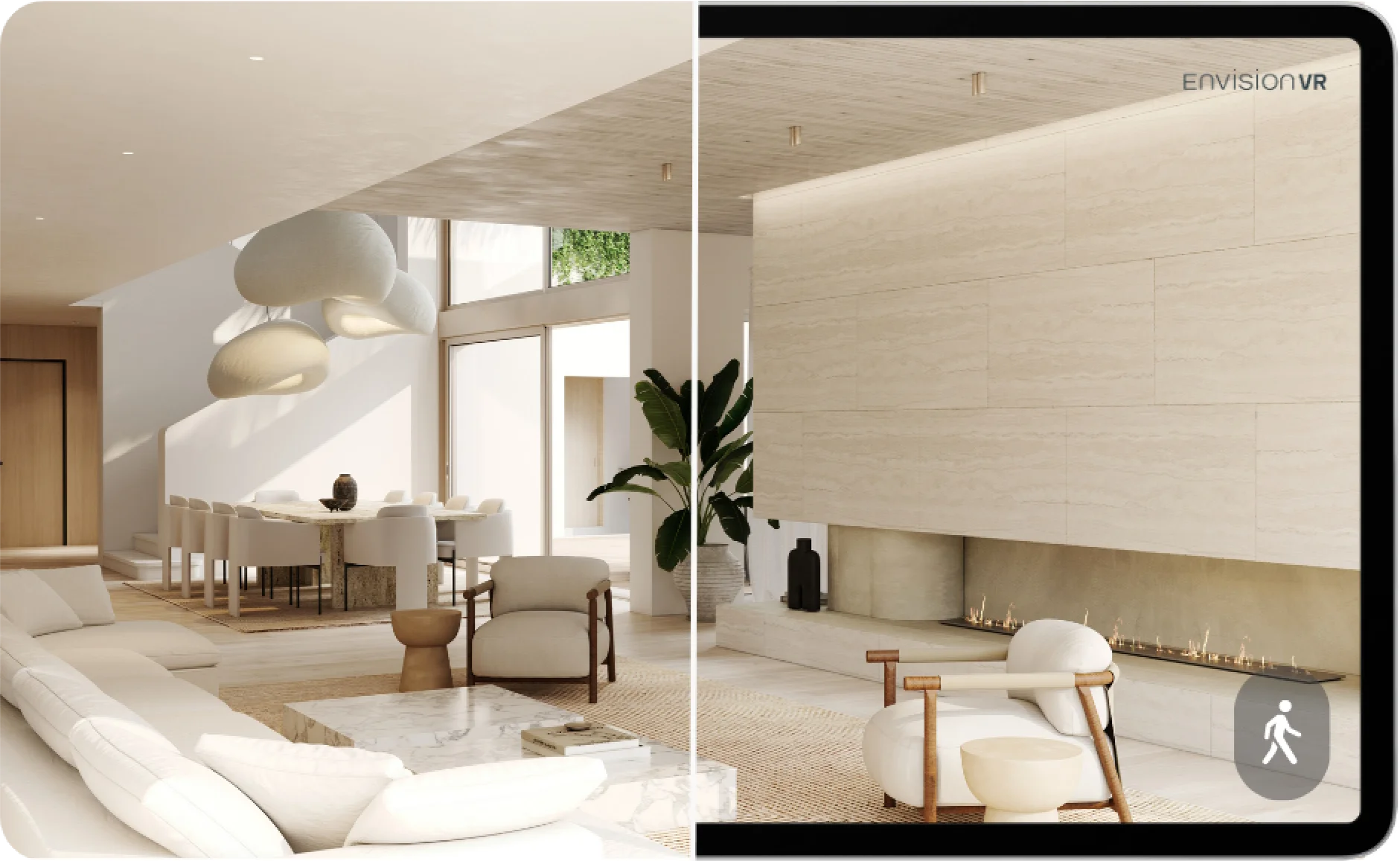
We get asked all the time, what are the differences between the render created for a project and EnvisionVR’s Virtual Experiences? At the highest level, EnvisionVR’s Virtual Experiences are an extension of the renders. Renders provide a static, single-angle view of an unbuilt space, whereas Virtual Experiences allow the viewer to freely explore the space as though it was already built. Both are incredibly powerful tools when showcasing and selling future projects.

Here you can see a render from one of our CGI Partners, Desirum. The hyperrealism of renders is achieved through the combination of the following:
- High-Quality 3D Modelling: Realistic renders start with accurate and detailed 3D models of the properties, including architectural elements, interior design, furniture, and landscaping. The models are created based on architectural plans to ensure precision.
- Texturing and Materials: Applying realistic textures and materials to the 3D models is crucial. This involves accurately representing the surfaces of various materials like wood, stone, metal, glass, fabric, and more. Artists use high-resolution texture maps and materials with accurate reflectivity, roughness, and other surface properties to mimic real-world materials.
- Lighting and Shadows: Lighting plays a significant role in creating realism. Artists use techniques to simulate how light interacts with the scene. They carefully position virtual light sources to replicate real-world lighting conditions, including sunlight, artificial lights, and ambient lighting. Shadows are accurately cast, considering the position and intensity of light sources, as well as objects within the scene.
- Reflections and Refractions: Realistic CGI renders incorporate reflections and refractions to simulate the behaviour of light when it interacts with reflective or transparent surfaces. This includes accurately representing reflections in glass windows, shiny surfaces, or water bodies, as well as the distortion of light passing through transparent materials like glass or water.
- Environmental Details: Paying attention to environmental details helps enhance realism. This includes both landscaping elements as well as atmospheric effects like fog, and haze to create depth and realism.
- Post-Processing: After the initial rendering, post-processing techniques are applied to refine and enhance the final image. This can involve colour grading, adjusting contrast and saturation, adding depth of field, and incorporating subtle imperfections or natural elements to simulate real-world photography.
When it comes to Virtual Experiences, EnvisionVR collaborates with the CGI studio that created the original render to extend the 3D model beyond what is seen in the rendered image. Once the entire 3D model of the space has been completed, EnvisionVR transforms it into an interactive environment that can be explored using mobile phones, tablets, VR headsets, or computers. This means that users can navigate and interact with the virtual space, enhancing their immersion and engagement.
To ensure a high-quality experience, that reflects the original renders and provides an accurate representation of the future space there are a few steps that EnvisionVR takes.
- Maintaining detail and fidelity. This includes preserving the quality of the modeling, textures, materials, lighting and shadows, reflections and refractions, and environmental details. By retaining these elements, EnvisionVR delivers a realistic experience that mirrors the original render.
- Life-like exploration tools. The EnvisionVR platform allows users to explore the future space as though it was already built. By enabling 1:1 scale walkthrough experience, users are completely immersed in the space and feel as though they are there, increasing their emotional connection to the project. There are no limitations to where the user can move in the space, and because of this, there is no fish-eye warping that occurs with 360-rendered hotspot tours.
- Incorporation of drone footage. Conveying what the future views of a project will be are a common selling point for developers and agents. EnvisionVR combines the CGI studios’ model with drone footage taken from the building site to enable accurate visualisation of the future space.
One of the differences you will notice between the two experiences in terms of imagery is the lack of post-processing techniques applied to the Virtual Experience. In renders, post-processing techniques are often employed to enhance the final image, adding effects such as colour correction, depth of field, motion blur, or lens flares. These post-processing effects are typically applied to create a more polished and aesthetically pleasing result in the static render.
Since Virtual Experiences are interactive and dynamic, the same post-processing effects used in renders are not applicable or feasible. Instead, EnvisionVR focuses on delivering real-time visuals that maintain a high level of realism and performance during user interaction. While this may result in some differences in terms of visual aesthetics when comparing a virtual experience to a render, the goal remains to provide an engaging and immersive environment that matches the CGI studio’s original design.
EnvisionVR’s Virtual Experiences and renders share the same foundation in terms of 3D model, textures, materials, lighting, and environmental details. The Virtual Experiences prioritise interactivity and real-time performance, while the CGI renders may incorporate additional post-processing effects to enhance the final static image. Both solutions work in harmony for clients looking to provide a new level of marketing interactivity for their projects.
Elevate your architectural model into, immersive XR


